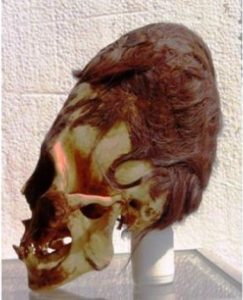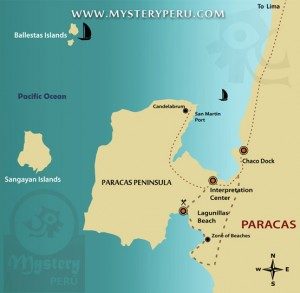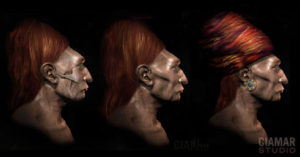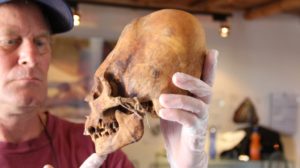[Don’t miss the updates at the bottom]
 Ica, Peru is an exciting place, if you happen to be interested in ancient cultures and archaeology. Many old world curiosities have come out of this region of the world, like the Ica Stones for instance, and in fact, one of the most impressive collections of ancient textiles came from Ica. That may seem quite the opposite of exciting to you, but to those of us who study such things, the findings of Peruvian archaeologist Julio C. Tello in the Paracas peninsula of the Pisco province of Ica, have been ground-breaking in terms of understanding at least one lost culture of Peru.
Ica, Peru is an exciting place, if you happen to be interested in ancient cultures and archaeology. Many old world curiosities have come out of this region of the world, like the Ica Stones for instance, and in fact, one of the most impressive collections of ancient textiles came from Ica. That may seem quite the opposite of exciting to you, but to those of us who study such things, the findings of Peruvian archaeologist Julio C. Tello in the Paracas peninsula of the Pisco province of Ica, have been ground-breaking in terms of understanding at least one lost culture of Peru.
In 1925, Julio Tello, the father of indigenous Peruvian archaeology, felt he was close to exposing the lost Paracas culture, and after a few years in field, he finally cracked the case for the Paracas when in 1927 he uncovered a necropolis in the desert that contained 429 ancient mummy bundles. This find proved the case for the Paracas culture, and it opened up vast avenues for research, including a study of the various patterned textiles used in the burial bundles.
 The Paracas people, for whom the entire Paracas peninsula is named, inhabited the coastal region from 800 BC to 100 AD, which makes them one of the oldest known Andean cultures. They had an aptitude for irrigation and water management, and their culture was rich in art and spiritual practices.
The Paracas people, for whom the entire Paracas peninsula is named, inhabited the coastal region from 800 BC to 100 AD, which makes them one of the oldest known Andean cultures. They had an aptitude for irrigation and water management, and their culture was rich in art and spiritual practices.
This is all well and good, it’s interesting but hardly headline worthy, at least not 87 years after the discovery, but there’s more to this situation than meets the eye.
The Paracas culture were one of the ancient Andean peoples who practised skeletal modification. They would bind the heads of their infants with rope, cloth and wooden boards in order to elongate their skulls. This was done for spiritual or religious reasons, and scholars believe it was an effort to make themselves look more like their deities.
The resulting skull shape does indeed seem otherworldly, and they’ve captured the attention of a great many Fortean researchers and Ancient Alien theorists. World famous Ancient Aliens proponent and author David Childress has long theorised that these elongated skulls are the product of contact between extraterrestrial beings at or before the height of the Paracas culture. He has alternately asserted that the Paracas skulls are either the result of attempts by humans to emulate these alien visitors, who may have been perceived as gods, or that they are the actual aliens.

Owner/curator of the local Paracas History Museum, Juan Navarro, has a collection of some 35 preserved examples of Paracas elongated skulls, as well as many other historical artefacts related to the Paracas culture. The skulls are said to have a cranial capacity of 24-40% larger than a regular human skull, which some claim is evidence that their brains were bigger and they were thus more intelligent than modern humans or humans of the same era. This is not necessarily true, but we’ll get to that.
In 2011, alternative history author Brien Foerster, and self-proclaimed expert on ancient elongated skulls, apparently convinced Navarro to allow several samples to be taken from the museum for analysis. Hair samples, including roots, a tooth, skull bone and skin samples were taken from five different skulls and were given to the late Lloyd Pye, of the Starchild Project fame, who then allegedly passed them on to an unnamed geneticist in Texas for DNA analysis (we can only hope it wasn’t DNA Diagnostics). [See update below]
Well, it seems Foerster would like us all to believe he has preliminary results of that analysis in hand, and through an appearance on JustEnergyRadio, he has released some rather spurious details that on first glance seem quite intriguing, but upon closer inspection, aren’t really all that impressive.
Several bloggers who specialize in the paranormal, have published posts telling of these preliminary conclusions, claiming that the DNA offered unexpected results. Headlines such as ‘Initial DNA analysis of Paracas elongated skulls released – with incredible result’ are giving people the wrong impression of the situation.
Foerster is claiming that mitochondrial DNA was found in at least one sample and that analysis of that DNA showed mutations that don’t conform to mutations known in humans or other animals.
“It had mtDNA (mitochondrial DNA) with mutations unknown in any human, primate, or animal known so far. But a few fragments I was able to sequence from this sample indicate that if these mutations will hold we are dealing with a new human-like creature, very distant from Homo sapiens, Neanderthals and Denisovans.”
What does that mean?
Not much really. At best it’s inconclusive. The DNA would be identified as human, but with anomalies; anomalies that could be caused by any number of contaminants or procedural flaws. It could be that this DNA really does provide unusual results, but the only thing that can be said of it at this point is that it requires further study. The sensational release of unconfirmed and unverifiable information such as this on a radio show, is not worthy of the attention this story is receiving.

Brien Foerster with an elongated skull
The problems don’t stop there, though.
Who is doing this analysis and where/when can we expect peer-reviewed publication of these results? Foerster isn’t telling, which sends up a huge red flag. In the quote above, Foerster refers to himself as doing the “sequencing”. Is this a slip of the tongue? He’s definitely not a geneticist. Secondary to this is the way in which he has “released” these findings, which is reminiscent of Melba Ketchum’s Bigfoot debacle of 2012. This is not the way science is done, though some might argue that he is not a scientist, and not much argument would be found in response.
Some people are buying into what seems to amount to Foerster’s latest effort to sell books, without really thinking about the situation critically. The Paracas elongated skulls are strange, but the features people like Foerster and Childress hold out as evidence that they have an other-worldly origin doesn’t really hold up to close scrutiny.
There are fossilized skulls of a race of proto-humans called the Boskop Man. They were found near a small town in South Africa of the same name, and these skulls sparked a heated debate among anthropologists and archaeologists when they were presented in 1913. They were given as evidence for a species of human that had a significantly larger brain and therefore greater intelligence than contemporary species. The Boskop skulls offered a cranial capacity of 40-50% larger than any other known humanoid species, but it’s been demonstrated that this doesn’t necessarily equate to greater intelligence. More isn’t always more.
The Paracas skulls, aside from looking strange, are anatomically identical to regular skulls, and since we know how and why their culture undertook skeletal modification, it seems credulous to inject conspiracy where none exists to begin with.
Where ever you see this story posted in the next couple weeks, be sure to ask how the poster verified the information Foerster is offering.
UPDATE:
As mentioned above, at the time of writing Brien Foerster hadn’t publicly identified the Texas geneticist that was processing these DNA samples, but Sharon Hill over at Doubtful News, along with some other sleuths, have determined that it is indeed Melba Ketchum of DNA Diagnostics who is performing the analysis. This information places this story squarely into the ‘seriously sketchy’ category, if it wasn’t there already.
UPDATE TO THE UPDATE:
This story is turning into a circus over at Doubtful News, as Foerster has threatened legal action against Sharon Hill (who used this post as the basis for hers), and has now directly denied the involvement of Melba Ketchum…sort of. He says he is working with her on this project, but that she didn’t work on the samples in question.
On top of everything, it’s been suggested that he may have violated international import/export laws, or at the very least Peruvian export laws, which require credentialed permits to remove any kind of archaeological material from the country. It appears Foerster had no such permit, though this is as yet unconfirmed.
